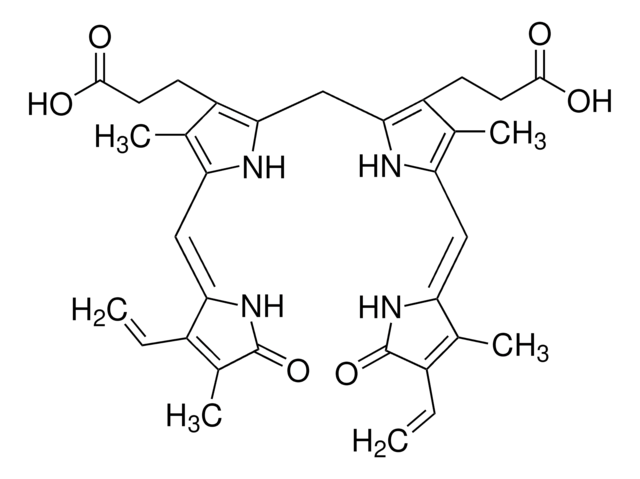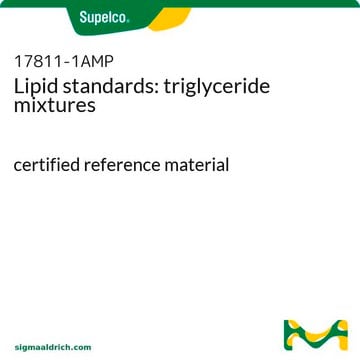This product, Intralipid, is a lipid emulsion comprising soybean oil.
I141
Intralipid
emulsion, lipid emulsion
Sinónimos:
Phospholipid stabilized soybean oil
Seleccione un Tamaño
US$ 255,00
Fecha estimada de envío02 de junio de 2025
Seleccione un Tamaño
About This Item
US$ 255,00
Fecha estimada de envío02 de junio de 2025
Productos recomendados
Nombre del producto
Intralipid, 20%, emulsion
Formulario
emulsion
concentración
20%
color
white
temp. de almacenamiento
2-8°C
Aplicación
- for testing its optical properties to be used as scattering medium for tissue phantom generation[1]
- as a component of agarose gel phantom to reduce scatter coefficients and background absorption[2]
- in infusion into mice in hyperinsulinemic-euglycemic clamps studies to evaluate its effect on nonesterified free fatty acids (NEFA) circulation[3]
Acciones bioquímicas o fisiológicas
Código de clase de almacenamiento
10 - Combustible liquids
Clase de riesgo para el agua (WGK)
WGK 3
Punto de inflamabilidad (°F)
Not applicable
Punto de inflamabilidad (°C)
Not applicable
Equipo de protección personal
Eyeshields, Gloves
Elija entre una de las versiones más recientes:
¿Ya tiene este producto?
Encuentre la documentación para los productos que ha comprado recientemente en la Biblioteca de documentos.
Los clientes también vieron
-
Hi I did use freeze-dry to convert intralipid to powder but what I have now is liquid, I was wondering that the intralipid is water base or oil base? because that makes difference in my research. Thnaks
1 answer-
Helpful?
-
-
I need to prepare a 500 ml phantom using Intralipid 20% and distilled water. How much Intralipid 20% should I add to the distilled water to achieve a reduced scattering coefficient of 8 cm−1?
1 answer-
Unfortunately, the scattering coefficient of this material has not been determined. The scattering coefficient of Intralipid 20% can vary due to differences in the concentrations of soybean oil, glycerin, phospholipids, free fatty acids, and pH between batches. Regarding the determination of the scattering coefficient in distilled water and establishing a reference value, the following citation from Biomedical Optics Express (2021) may be of interest.
Biomed Opt Express. 2021 Oct 7;12(11):6814-6830.
Investigation of methods to extract confocal function parameters for the depth-resolved determination of attenuation coefficients using OCT in intralipid samples, titanium oxide phantoms, and in vivo human retinas
https://pubmed.ncbi.nlm.nih.gov/34858682/Helpful?
-
-
Hi. Do you know what is extinction coefficient at 680 nm and molecular weight of this product? Thank you
1 answer-
Unfortunately, the extinction coefficient is not determined for this product. This is a multi-component material containing a range of fatty acids and phospholipids, the molecular weight is not available.
Helpful?
-
-
Hello, I am using IL-20 for tissue phantoms. Is the 20% concentration a volume/volume concentration or something different?
1 answer-
The concentration is specified as 20% weight/weight (w/w).
Helpful?
-
-
Is this solution sterile?
1 answer-
Yes. Intralipid 20% is a sterile product. The product is sterilized in its final container.
Helpful?
-
-
Is there a concentration for Intralipid 20% in mg/mL? Or a density value in order to calculate concentration in mg/mL?
1 answer-
The density of Intralipid, 20% is 0.99 g/mL at room temperature. The "20%" in the product name is a nominal value; the specification for the concentration is 18.0 to 22.0 percent on a weight-to-weight basis. Based on a density of 0.99 g/mL, that would convert to a weight-to-volume percentage of soybean oil of 17.8 to 21.8 percent, or 178-218 g/mL.
Please navigate to the DOCUMENTATION section of the Product Detail Page to access a Certificate under ‘Certificate of Analysis’:
https://www.sigmaaldrich.com/product/sigma/i141#product-documentationHelpful?
-
-
Is there a shelf life for this product or after opening?
1 answer-
This product is not assigned an expiration date or recommended retest date. Products with no expiration date or recommended retest date should be routinely inspected by customers to ensure they perform as expected. These products are also subject to a one year warranty from the date of shipment. For more information you may access the "Product Dating Information" document under "ADDITIONAL USEFUL DOCUMENTS ABOUT OUR PRODUCTS" at the bottom of the Quality Services page with this link: https://www.sigmaaldrich.com/life-science/quality-and-regulatory-management/quality-services.
Helpful?
-
-
What are the components of Product I141, Intralipid?
1 answer-
This Intralipid is made up of 20% soybean oil, 1.2% egg yolk phospholipids and 2.25% glycerin; the remainder is water.
Helpful?
-
-
Can Product I141, Intralipid, be used in cell culture?
1 answer-
We have not tested this product for cell culture application. An article by Per Oscarsson, A., et al., Acta Anaesthesiol. Scand. 45, 1215-1220 (2001), used Intralipid in cell culture with primary cultured rat neurons at 1.0 mg/mL for 20 minutes.
Helpful?
-
-
What is the Department of Transportation shipping information for this product?
1 answer-
Transportation information can be found in Section 14 of the product's (M)SDS.To access the shipping information for this material, use the link on the product detail page for the product.
Helpful?
-
Active Filters
Nuestro equipo de científicos tiene experiencia en todas las áreas de investigación: Ciencias de la vida, Ciencia de los materiales, Síntesis química, Cromatografía, Analítica y muchas otras.
Póngase en contacto con el Servicio técnico










